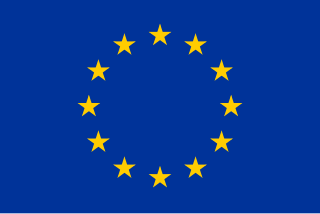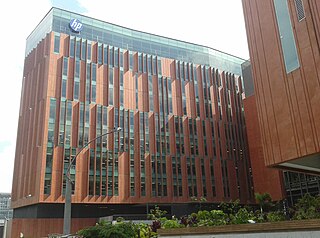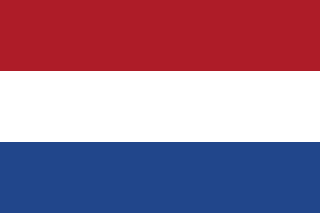Related Research Articles

The economy of Slovakia is based upon Slovakia becoming an EU member state in 2004, and adopting the euro at the beginning of 2009. Its capital, Bratislava, is the largest financial centre in Slovakia. As of Q1 2018, the unemployment rate was 5.72%.

Innovation is the practical implementation of ideas that result in the introduction of new goods or services or improvement in offering goods or services. ISO TC 279 in the standard ISO 56000:2020 defines innovation as "a new or changed entity, realizing or redistributing value". Others have different definitions; a common element in the definitions is a focus on newness, improvement, and spread of ideas or technologies.

The knowledge economy, or knowledge-based economy, is an economic system in which the production of goods and services is based principally on knowledge-intensive activities that contribute to advancement in technical and scientific innovation. The key element of value is the greater dependence on human capital and intellectual property as the source of innovative ideas, information, and practices. Organisations are required to capitalise on this "knowledge" in their production to stimulate and deepen the business development process. There is less reliance on physical input and natural resources. A knowledge-based economy relies on the crucial role of intangible assets within the organisations' settings in facilitating modern economic growth.
Small and medium-sized enterprises (SMEs) or small and medium-sized businesses (SMBs) are businesses whose personnel and revenue numbers fall below certain limits. The abbreviation "SME" is used by many national agencies and international organizations such as the World Bank, the OECD, European Union, the United Nations, and the World Trade Organization (WTO).
In business administration, absorptive capacity is defined as a firm's ability to recognize the value of new information, assimilate it, and apply it to commercial ends. It is studied on individual, group, firm, and national levels. Antecedents are prior-based knowledge and communication. Studies involve a firm's innovation performance, aspiration level, and organizational learning. It has been said that in order to be innovative an organization should develop its absorptive capacity.
The National Innovation System is the flow of technology and information among people, enterprises and institutions which is key to the innovative process on the national level. According to innovation system theory, innovation and technology development are results of a complex set of relationships among actors in the system, which includes enterprises, universities and government research institutes.
City region is a term used by urbanists, economists and urban planners to refer to how one or more core cities are linked to a hinterland by functional ties, such as economic, housing-market, commuting, marketing or retail catchment factors. This concept emphasizes the importance of these functional relationships in understanding urban areas and their surrounding regions, often providing more insightful perspectives than the arbitrary boundaries assigned to administrative bodies.
New public management (NPM) is an approach to running public service organizations that is used in government and public service institutions and agencies, at both sub-national and national levels. The term was first introduced by academics in the UK and Australia to describe approaches that were developed during the 1980s as part of an effort to make the public service more "businesslike" and to improve its efficiency by using private sector management models.

The European Structural and Investment Funds are financial tools governed by a common rulebook, set up to implement the regional policy of the European Union, as well as the structural policy pillars of the Common Agricultural Policy and the Common Fisheries Policy. They aim to reduce regional disparities in income, wealth and opportunities. Europe's poorer regions receive most of the support, but all European regions are eligible for funding under the policy's various funds and programmes. The current framework is set for a period of seven years, from 2021 to 2027.
A regulatory impact analysis or regulatory impact assessment (RIA) is a document created before a new government regulation is introduced. RIAs are produced in many countries, although their scope, content, role and influence on policy making vary.

Dylan Jones-Evans was born in Bangor, Gwynedd and brought up in Pwllheli on the Llyn Peninsula. He is currently Assistant Pro-Vice-Chancellor (Enterprise) and the chair in entrepreneurship at the University of South Wales. He is visiting professor of entrepreneurship at the University of Turku in Finland, newspaper columnist and the creator of the Wales Fast Growth 50, an annual barometer of entrepreneurial firms in Wales.
The URBAN AND REGIONAL INNOVATION Research (URENIO) is a university lab in the Department of Urban and Regional Planning, School of Engineering at the Aristotle University of Thessaloniki. URENIO is a non-profit research organization that started its operation in 1995. URENIO is mainly involved in competitive projects from the European R&D Framework Programs (FP), the Competitiveness and Innovation Program (CIP), the territorial cooperation programs, the OECD, and the United Nations.

Research and development intensity is generally defined as expenditures by a firm on its research and development (R&D) divided by the firm's sales. There are two types of R&D intensity: direct and indirect. R&D intensity varies, in general, according to a firm's industry sector, product knowledge, manufacturing, and technology, and is a metric that can be used to gauge the level of a company's investment to spur innovation in and through basic and applied research. A further aim of R&D spending, ultimately, is to increase productivity as well as an organization's salable output.
An entrepreneurial ecosystem or entrepreneurship ecosystems are peculiar systems of interdependent actors and relations directly or indirectly supporting the creation and growth of new ventures.
Innovation districts are urban geographies of innovation where research and development (R&D) strong institutions, companies, and other private actors develop integrated strategies and solutions to develop thriving innovation ecosystems–areas that attract entrepreneurs, startups, and business incubators. Unlike science parks, innovation districts are physically compact, leverage density and high levels of accessibility, and provide a “mash up” of activities including housing, office, and neighborhood-serving amenities. Districts signify the collapse back of innovation into cities and is increasingly used as a way to revitalize the economies of cities and their broader regions. As of 2019, there are more than 100 districts worldwide.

Corporation Ruta N is a public joint venture between the mayor's office of Medellín, UNE and EPM. Founded in 2009, Ruta-N was created in order to inspire and encourage innovation in the city and create favorable conditions for business and entrepreneurship.
The quadruple and quintuple innovation helix framework describes university-industry-government-public-environment interactions within a knowledge economy. In innovation helix framework theory, first developed by Henry Etzkowitz and Loet Leydesdorff and used in innovation economics and theories of knowledge, such as the knowledge society and the knowledge economy, each sector is represented by a circle (helix), with overlapping showing interactions. The quadruple and quintuple innovation helix framework was co-developed by Elias G. Carayannis and David F.J. Campbell, with the quadruple helix being described in 2009 and the quintuple helix in 2010. Various authors were exploring the concept of a quadruple helix extension to the triple helix model of innovation around the same time. The Carayannis and Campbell quadruple helix model incorporates the public via the concept of a 'media-based democracy', which emphasizes that when the political system (government) is developing innovation policy to develop the economy, it must adequately communicate its innovation policy with the public and civil society via the media to obtain public support for new strategies or policies. In the case of industry involved in R&D, the framework emphasizes that companies' public relations strategies have to negotiate ‘reality construction’ by the media. The quadruple and quintuple helix framework can be described in terms of the models of knowledge that it extends and by five subsystems (helices) that it incorporates; in a quintuple helix-driven model, knowledge and know-how are created and transformed, and circulate as inputs and outputs in a way that affects the natural environment. Socio-ecological interactions via the quadruple and quintuple helices can be utilized to define opportunities for the knowledge society and knowledge economy, such as innovation to address sustainable development, including climate change.

Science and technology in the Netherlands has an extended history, producing many notable achievements and discoveries in the field. It is an important component in the economic and societal development of the Netherlands. The Dutch government is a driver of scientific and technological progress with science expenditure passing €4.5 billion every year.

Francesco Grillo is an Italian economist and manager.
Jennifer J. Clark is an American academic and author. Clark is Knowlton School Distinguished Professor and Head of the City and Regional Planning Section, in the College of Engineering at Ohio State University. She is a Fellow of the American Association of Geographers, and a Fellow of the Regional Studies Association. Clark twice won the Best Book Award from the Regional Studies Association in 2009, and in 2022. She is also the recipient of the 2021 Urban Affairs Association's Best Book Award.
References
- ↑ Agrawal, A.; Cockburn, I.; Galasso, A.; Oettl, A. (2014). "Why are some regions more innovative than others? The role of small firms in the presence of large labs". Journal of Urban Economics. 81: 149–165. doi:10.1016/j.jue.2014.03.003.
- ↑ Kindt, Anna-Maria; Geissler, Matthias; Bühling, Kilian (2022-04-28). "Be my (little) partner?!—Universities' role in regional innovation systems when large firms are rare". Journal of Regional Science. 62 (5): 1274–1295. Bibcode:2022JRegS..62.1274K. doi: 10.1111/jors.12596 . ISSN 0022-4146. S2CID 248340304.
- ↑ KOUKOUFIKIS G., 2014. The incorporation of EU's Innovation Policy in its Regions. Insights from Basse Normandie and Thessaly. Polytech' Tours, Universite Francois-Rabelais, Tours, France. Available at: <https://www.academia.edu/8387357/The_incorporation_of_EUs_Innovation_policy_in_its_regions_Insights_from_Basse-Normandie_and_Thessaly>
- ↑ "Systèmes régionaux d'innovation (RIS) concrètement: Du conseil et du financement à la numérisation | http://www.regiosuisse.ch – la plate-forme du développement régional en Suisse | regiosuisse".
{{cite web}}: External link in|title= - ↑ https://www.seco.admin.ch/dam/seco/en/dokumente/Publikationen_Dienstleistungen/Publikationen_Formulare/Standortfoerderung/Broschueren/Die%20Neue%20Regionalpolitik%20des%20Bundes.pdf.download.pdf/seco-nrp-broschure-en.pdf [ bare URL PDF ]
- ↑ "Regional Development Policy - OECD".
- ↑ "OECD Territorial Reviews".
- ↑ "Regional Innovation - OECD".
- ↑ Morisson, Arnault (2018). "Knowledge Gatekeepers and Path Development on the Knowledge Periphery: The Case of Ruta N in Medellin, Colombia". Area Development and Policy. 4: 98–115. doi:10.1080/23792949.2018.1538702. S2CID 169689111.
- ↑ Morisson, A. & Doussineau, M. (2019). Regional innovation governance and place-based policies: design, implementation and implications. Regional Studies, Regional Science,6(1),101–116. https://rsa.tandfonline.com/doi/full/10.1080/21681376.2019.1578257.